UNDER THE SKIN: PORSCHE CARRERA CUP CAR – THE BEST YET
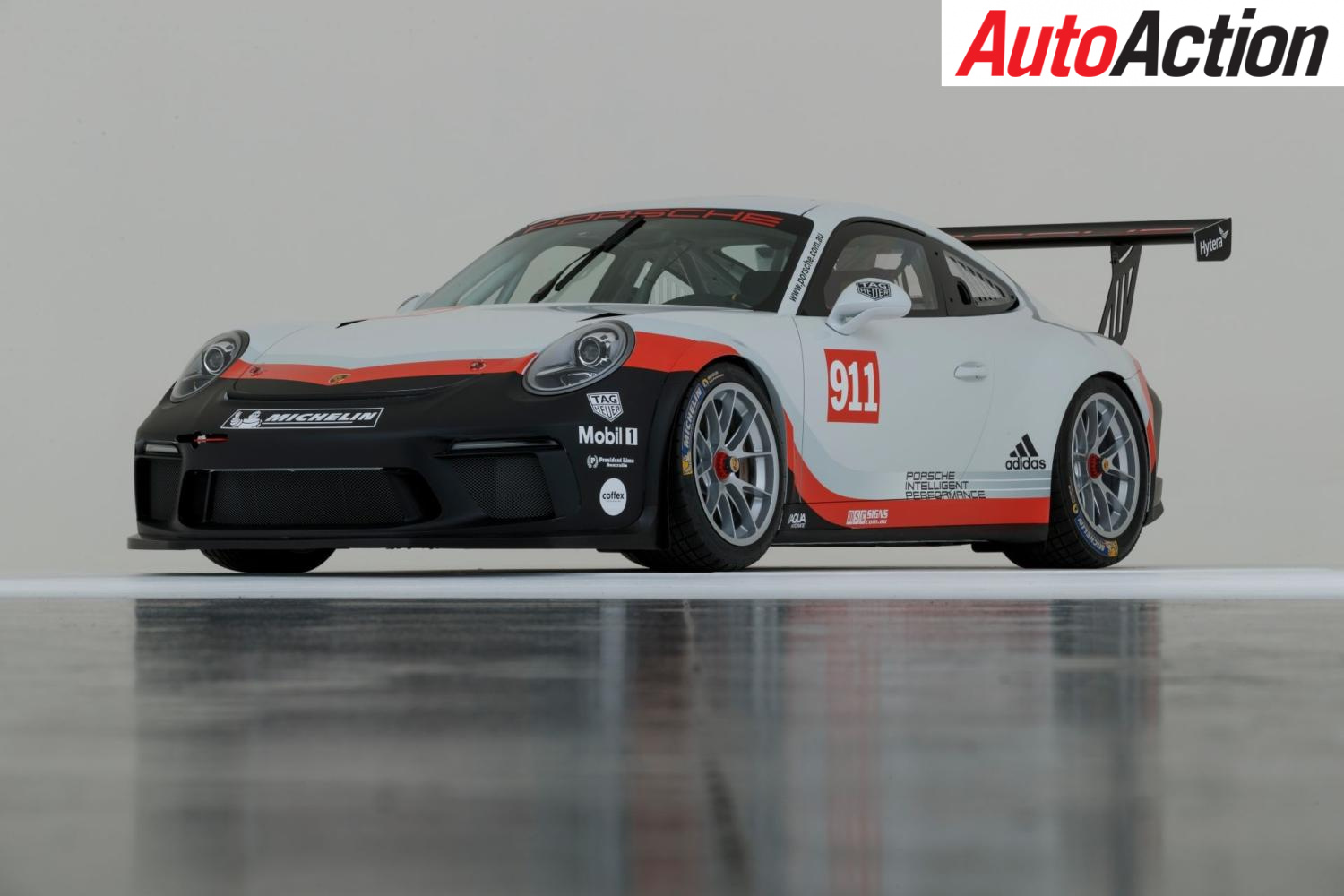
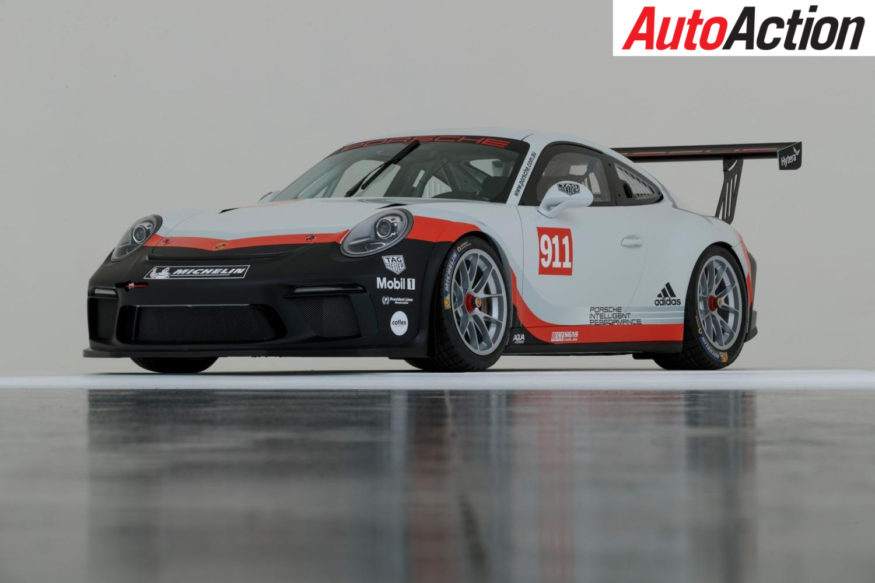
The new 2018 Porsche Carrera Cup car
Porsche Carrera Cup has been a staple of the Supercars Championship support program since 2003 and has aided in the development of some of the sports rising stars. Last year, Porsche released a new 991 GT3 Cup Car, and has been recently unveiled in Australia. So Auto Action took a look to see what all the fuss was about.
By HEATH McALPINE
NEXT YEAR, a new era will begin in Carrera Cup when the fifth generation of Porsche’s 911 variant races down under next year.
The car was launched prior to the Phillip Island Pro-Am round as part of the Shannons Nationals round in late May, but has already debuted in both the Porsche Supercup and the German Carrera Cup Series this year.
The car is not just a refinement of a winning formula, which has seen Porsche build over 3000 examples of the Cup Car worldwide variant since 1998. Since the introduction of Carrera Cup Australia in 2003, it has provided both a pathway for young drivers such as Fabian Coulthard, David Reynolds, Nick Percat and David Wall to progress through to the Main Game, and an opportunity for Amateur drivers to compete test themselves against these youngsters. In other cases, it has led to overseas opportunities, namely Matt Campbell through winning the Porsche Young Driver Shootout resulting in a fully funded Supercup drive this year, and Nick Foster, who is currently competing in the World Endurance Championship with Porsche team, Gulf Racing.
The second generation ‘991’ Cup Car had its public reveal at the Paris Motor Show in September 2016 and its debut race meeting at Hockenheim on May 6-7. It is the second racer based on the current generation of the 911, after the GT3-spec GT3R, which was launched at the end of 2015. The third racer, the 991 GT3 RSR that races in the WEC and IMSA series, rolled out at the start of this year.
“We’ve never taken such a big leap,” said Porsche Motorsports Chief Frank-Steffen Walliser at the launch of the GT3 Cup Car.
“After the GT3R, it’s the second car with our new generation of engines.”
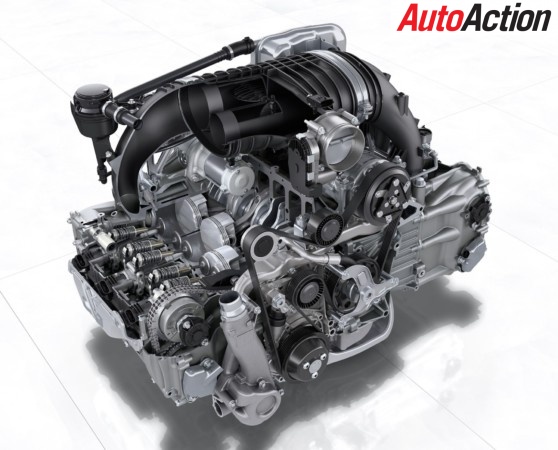
The Aluminium six-cylinder horizontally opposed engine used in 991 GT3 Cup Car
The engine to which Walliser refers is a completely new engine developed by Porsche for their motorsport activities. The motor is a naturally aspirated 4.0-litre flat-six-cylinder engine, which produces 357kw of power and 480Nm of torque. The torque figure is quite important because this is where the most ground has been made up compared to the first-generation of the 991 GT3 Cup Car that was introduced in 2014 here in Australia.
The Porsche engineering team has worked extremely hard to improve the cars torque at low revs, which has proven to be a success as drivers such as Campbell and current Supercup leader Michael Ammermuller have praised the increased power and torque provided.
“The new car is really good and it drives very similarly to the old car, just with more low-down torque and more power than its predecessor,” Campbell explained after testing the new car before the first round at Catalunya.
“It’s all been a pretty amazing experience so far.”
Adding to better power and torque figures, the new engine is cheaper and more reliable to run than the previous 3.8-litre flat-six, thanks to new innovations including a valve drive with rigidly mounted rocker arms, a significantly more rigid crankshaft has been installed, a central oil feed and an integrated oil centrifuge, which optimises oil defoaming in the engine.
This means that the new engine can run double the amount of time compared to the previous model, which significantly reduces running costs. The new engine can run from 50 to 100 hours between rebuilds, while the current 3.8-litre motor runs up to 40 hours between rebuilds.
Surprisingly, the new engine has incorporated an innovation that was first released in the 991 911 road car, direct fuel injection. Walliser is excited by the transfer of technology between the road and race division and its ability to work in both directions thanks to both production and motorsport departments collaborating frequently.
“The intensive exchange between colleagues from motorsport and production development is everyday practice for us,” Walliser explains. “In the motorsport department we have a great interest, of course, in ensuring that as many components as possible are realised in the basis car.
“In turn, the colleagues from production development are keen to participate in the experiences from motor racing and adopt appropriate measures into the production car.”
This doesn’t mean that much of the development isn’t done in motorsport, and as the 991 GT3 Cup Car is the closest to production car-spec compared to the GT3R and the GT3 RSR, this is where most of the learning can be done.
“We’ve gained a lot of experience over recent years, especially with the normally aspirated engine, and you notice this one-to-one with our road-going engine,” continued Walliser.
“A great deal of ideas flow from motor racing into our production cars. The lateral air intakes, for instance, was trialled in the GT race car and then transferred to the 911 GT3 RS. The same goes for the aerodynamic components like the position and size of the rear wing. The central front air vent and various efficiency measures in the engine, for example the high-rev concept, come from the race car.
“Because it’s the very same employees who build the road-going and race vehicles, a kind of natural technology transfer takes place. The colleagues do not forget what they did on the race car, but carry this know-how over to the street car and try out things they believe might also work.”
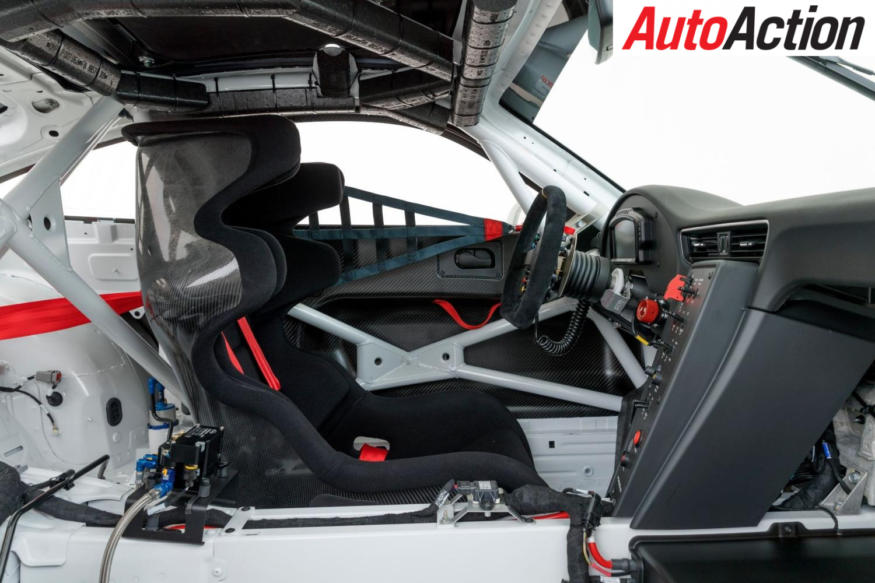
The interior of the new Porsche 991 GT3 Cup Car
Not only do Porsche themselves look at the development of their customer cars but they also look to customers to help improve and evolve the product, which has been done with the 991 Cup Car.
“Our customers are intensively engaged with the product and hence have a wealth of experience, enthused Walliser. “They race our cars each weekend somewhere around the globe. Many great ideas evolve, these flow back to us and we happily pick them up. This is a useful technological transfer for everyone – for us and our customers.”
This philosophy has been taken when considering the improvements required from the new motor as well as the interior, which has seen minimal change compared to the first generation because it meets the customer’s needs.
Aerodynamically, the car is much slipperier than the previous generation thanks to revised front and rear air dams, which has seen a significant improvement in downforce as well air flow. These new items add to the 184cm rear wing that has been retained from the previous model and a completely redesigned rear diffuser. The rear wing can be set up in nine different positions depending on the type of track, while the rear diffuser not only provides downforce but also filters cool air into the brakes and gearbox of the car.
The new 991 has been upgraded to match the recent update to the road car version with slight changes to the taillights and the inclusion of front bumper lights and a rain light in the revised rear bodywork. All lights are the latest in LED technology.
Carbon fibre doors and the rear lid provided an easy way for the engineers to start the weight-loss as were the replacement of the rear side windows and rear screen with a polycarbonate replica. These items add to the lightweight aluminium bodyshell that once constructed, tips the scales at 1200kg.
A new initiative for next year for the Elite or gentlemen class drivers will be the inclusion of an ABS system developed by the Porsche’s factory team in Europe, Manthey Racing. The way the 991 Cup Car has been set up allows straight forward installation of the system with derivative sensor and harness allowing retrofitted.

New ABS system for Elite or gentlemen class drivers
Apart from the ABS, stopping power is given by a pair of six-piston brake calipers at the front and four-piston brake calipers at the rear, with ‘anti-knock back’ piston springs. 380mm steel internally vented and slotted steel brake discs are fitted to each corner of the car, while a pair of independent brake circuits runs to each axle with a brake pressure sensor on each, can be adjusted by the driver via a brake balance system.
Perhaps the biggest chance in the car is the use of ABS. While not new in itself, the way that the system will be implemented in the 2018 series is; it will be mandatory for the ‘Elite’ (ie, amateur) drivers while the Pros will race without it.
The transmission has also been overhauled and has been made a more reliable unit. The Porsche six-speed sequential transmission features a sintered metal racing clutch and internal pressure-oil lubrication to keep the transmission fluids at optimum performing temperature. This is done via an oil-water heat exchange. The electropneumatic gear changes are made using paddle shift, which has become standard for the latest production and racing GT cars. As the engine has doubled its running time between services, so has the transmission, which only requires a rebuild at 30 to 60 hours. This further reduces the running costs for Carrera Cup teams.
Inside, the second generation 991 Cup Car features the same interior as its predecessor, though safety improvements were a primary focus. A newly designed roll cage meets the latest FIA safety measures, as does the removable roof section that has been enlarged for easy initial treatment and extraction after an accident. Porsche have also redesigned a racing bucket seat that protects the upper part of the body, mainly the head and shoulders, while leg protection has been taken into account via as a shock-absorbing roll cage cover has been integrated into the driver’s footwell.
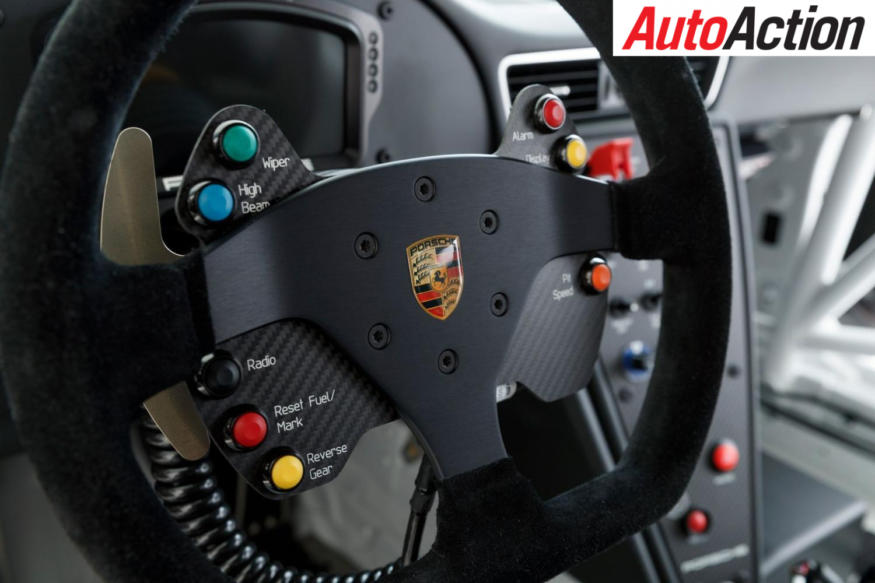
Some items like the steering wheel carry over from the previous model
The positioning of the buttons and switches has not been tampered with, while the quick release steering is another item to carryover. Improved software will enable vehicle diagnostics to be performed on the steering wheel display, while a variety of extra sensors will increase the data that can be extracted from the car. This will help teams increase their understanding of what reaction the car has to a variety of set-up changes, which will be important when this car races for the first time next year.
Another item that Porsche thought unnecessary to change was the suspension. McPherson struts at the front and a multi-link rear suspension continues to give Carrera Cup drivers a user-friendly car in the handling stakes, while the adjustable height, camber and toe is still the point of difference that can make or break that user-friendly handling. Forged top mounts (adjustable at the front), H&R Springs and Sachs non-adjustable shock absorbers are standard equipment across the field, leaving it up to the driver and team to find the cars prime set-up. As with previous generations, the car features power steering.
An 18-inch lightweight alloy, one-piece Porsche specification rim is wrapped in a Michelin slick tyre with the rear guards being pumped out to fit the 310mm wide rear tyre package, while the width up front is 270mm.
Even though, generally, Porsche updates their Carrera Cup cars every three years, this new machine is set to raise the bar in one-make racing worldwide. It has shown to be a massive improvement over its predecessor overseas and provides Porsche with a strong connection between each level of its GT ladder, thanks to the common engine each specification of the car features.
The Porsche Motorsport pyramid has seen drivers the calibre of Earl Bamber and Nick Tandy climb to the pinnacle, an LMP1 drive, and one that Campbell hopes to reach. At the base of the pyramid, the GT3 Cup Car provides the important initial stepping stone for an aspiring driver .
“Racing series like the Porsche Carrera Cup and the Porsche Mobil 1 Supercup are true driver championships,” Walliser said.
“The cars are almost identical and those who master them the best are good drivers. Our youth development programme, which we launched in 1997 with the first Porsche Junior team, is consistent, long-term and successful: Many of our current works drivers came from here. This shows once again: Porsche opens all doors to those who are talented and really fast.”
And this is why there is a big fuss about the new Porsche 991 GT3 Cup Car.
PORSCHE 991 GT3 CUP CAR
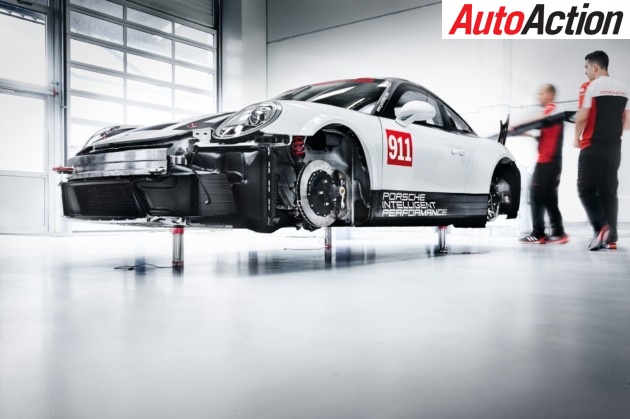
Under The Skin of the new Porsche Carrera Cup
Engine: Aluminium six-cylinder horizontally opposed engine, rear-mounted, water-cooled with thermal management for engine and transmission, four valves per cylinder, direct fuel injection, dry-sump lubrication, Bosch MS 4.6 NG engine management, ‘Supercup’ open exhaust.
Power: 357kw
Torque: 480nm
Transmission: Six-speed sequential dog-type transmission, pneumatic gearshift activation (paddle shift), triple-disc sintered metal racing clutch.
Brakes:
Front: Six-piston aluminium Monobloc racing brake calipers with ‘anti-knock’ piston springs.
Rear: Four-piston aluminium Monobloc racing brake calipers with ‘anti-knock’ piston springs.
Multi-piece steel brake discs, internally vented and slotted, 380mm diameter, two independent brake circuits with brake pressure sensors for front and rear axle, adjustable by the driver via brake balance system, Manthey Racing ABS system for Elite Class drivers.
Suspension:
Front: McPherson strut, forged and adjustable top mounts.
Rear: Multi-link rear suspension, forged mounts.
Sachs non-adjustable shock absorbers, H&R springs.
Bodyshell: Lightweight construction in aluminium and steel composite, weld-in roll cage, removable roof section, modified and widened 911 GT3 wings, enlarged rear wheel arches, carbon-reinforced plastic doors and rear lid, polycarbonate rear side windows and rear screen.
Weight/dimensions:
Weight: 1200kg
Length: 4564mm
Width: 1980mm
Height: 1246mm
Wheelbase: 2456mm
After Auto Action’s latest Under the Skin feature? Pick up the current issue of the magazine, in stores now. Also follow us on social media Facebook, Twitter and Instagram for all the latest news.




